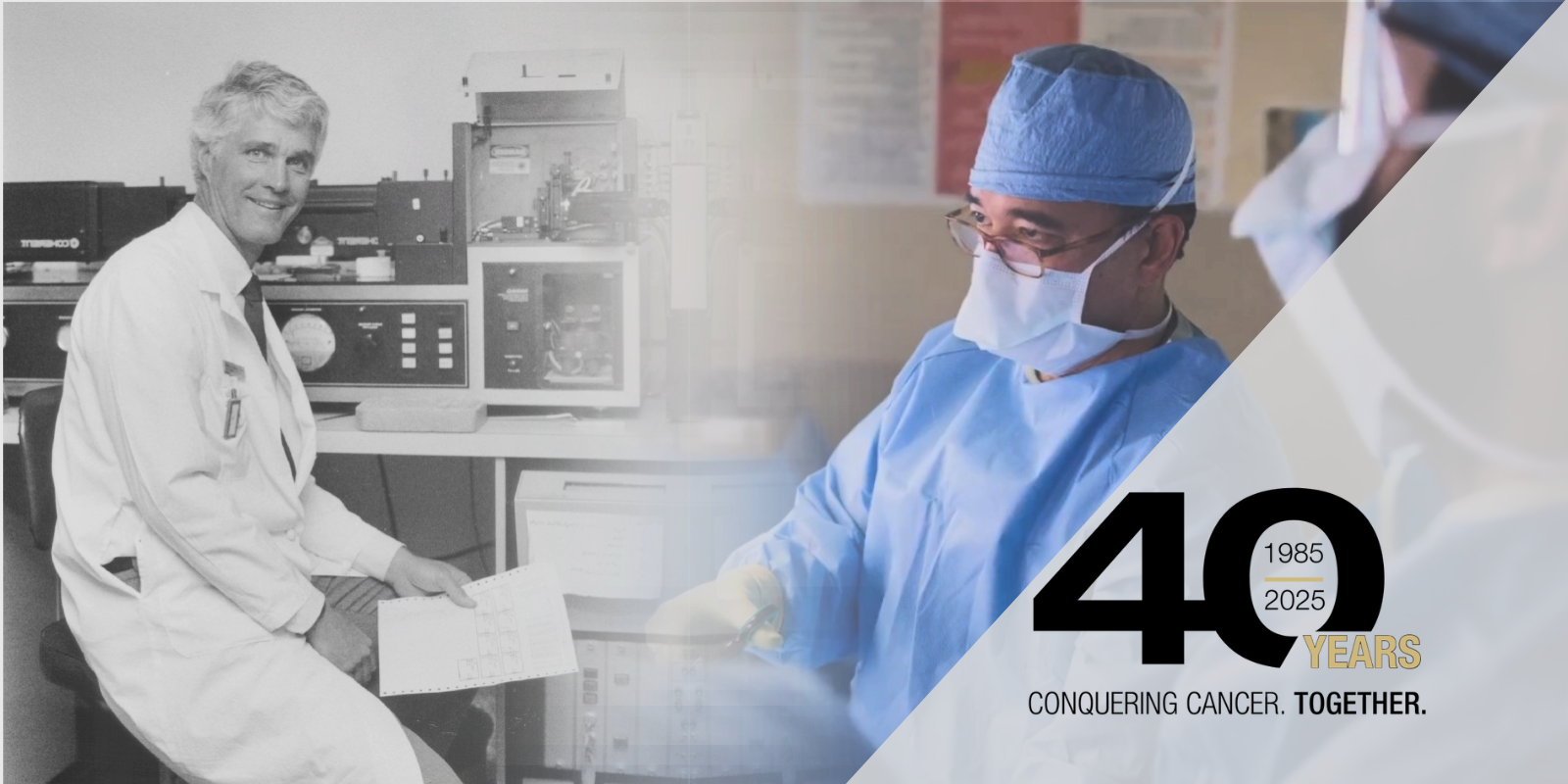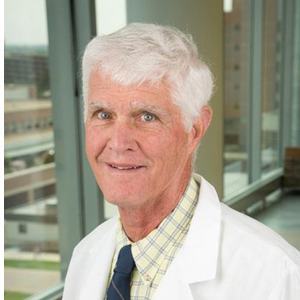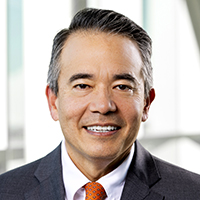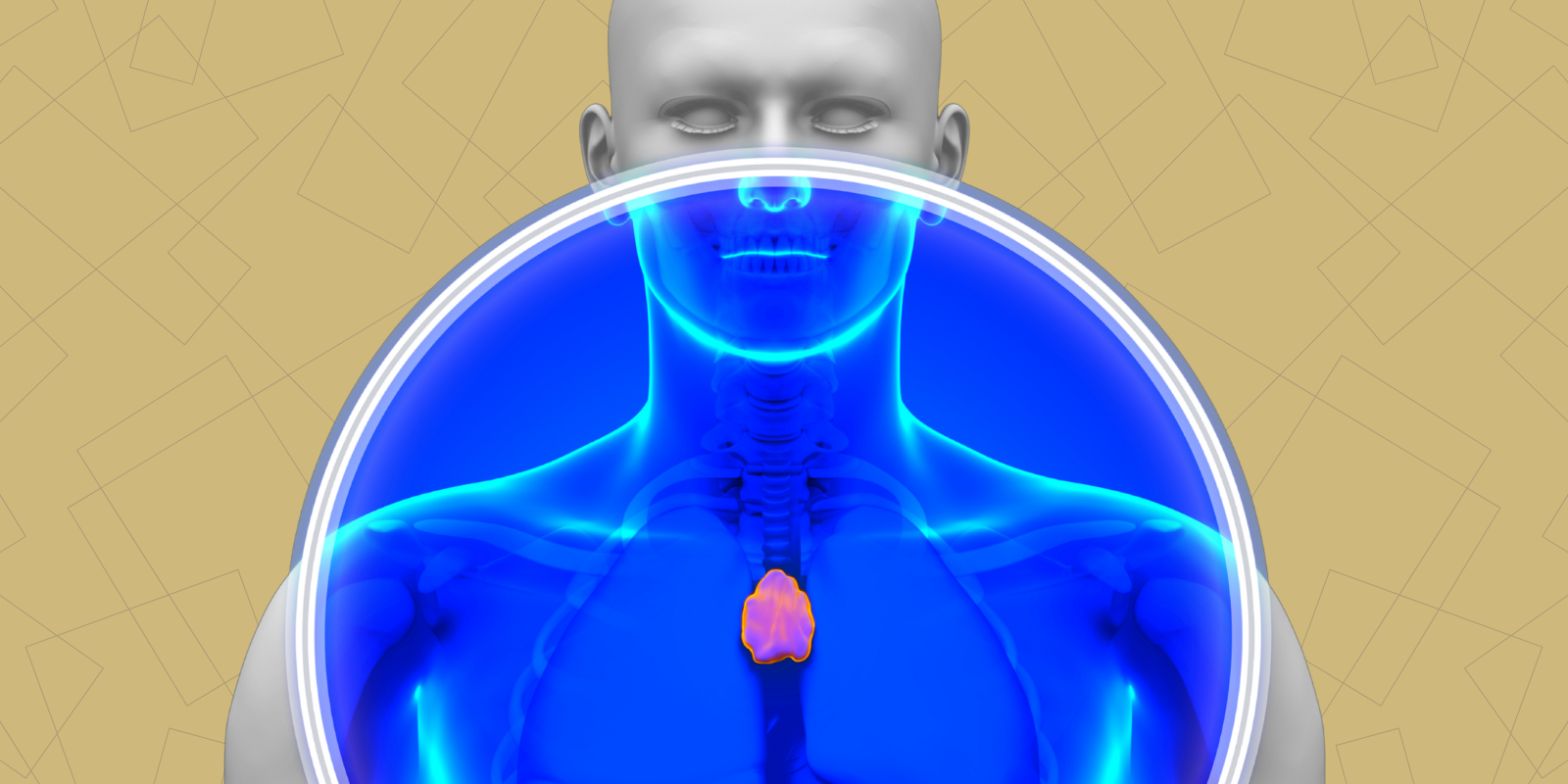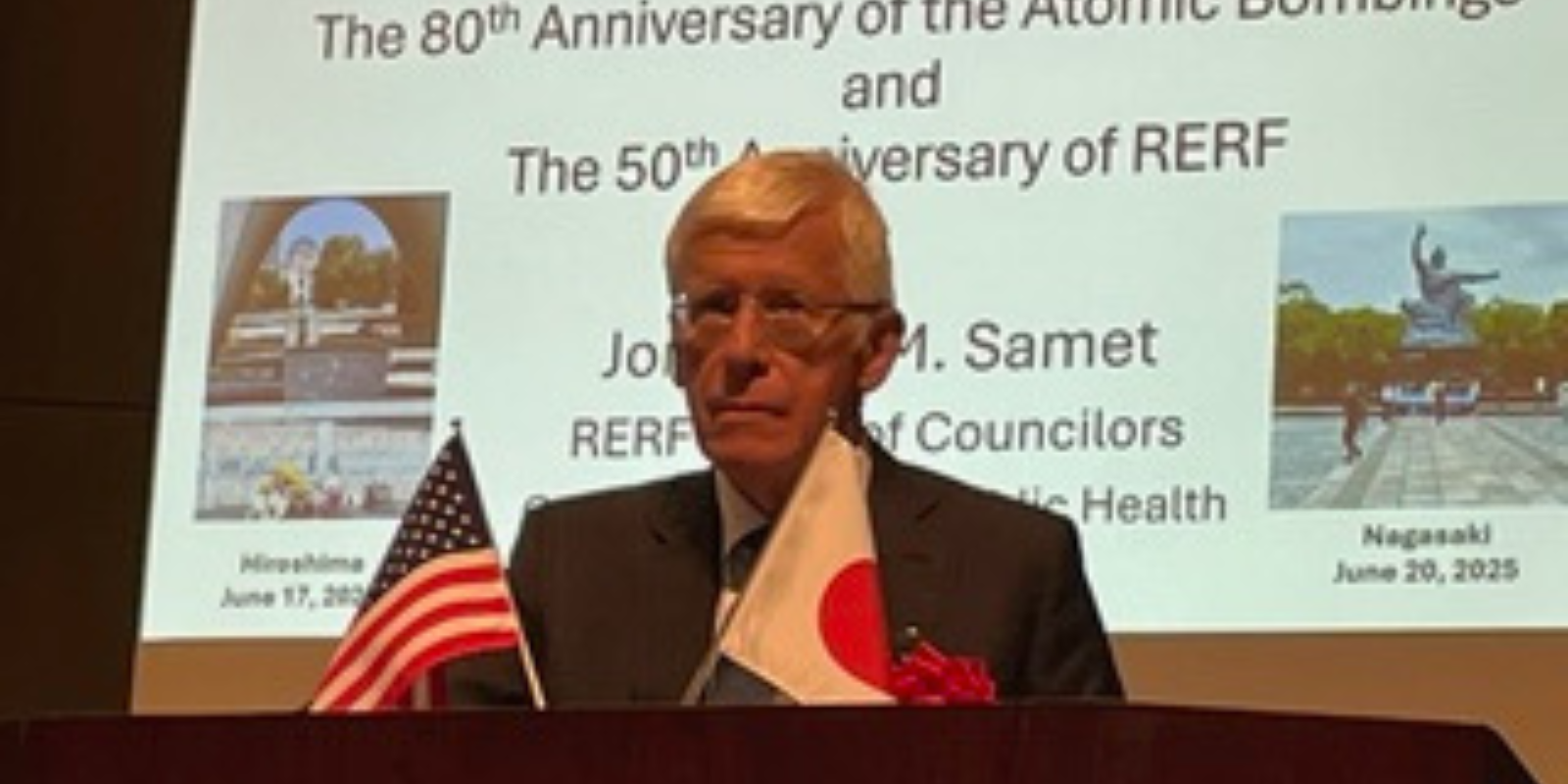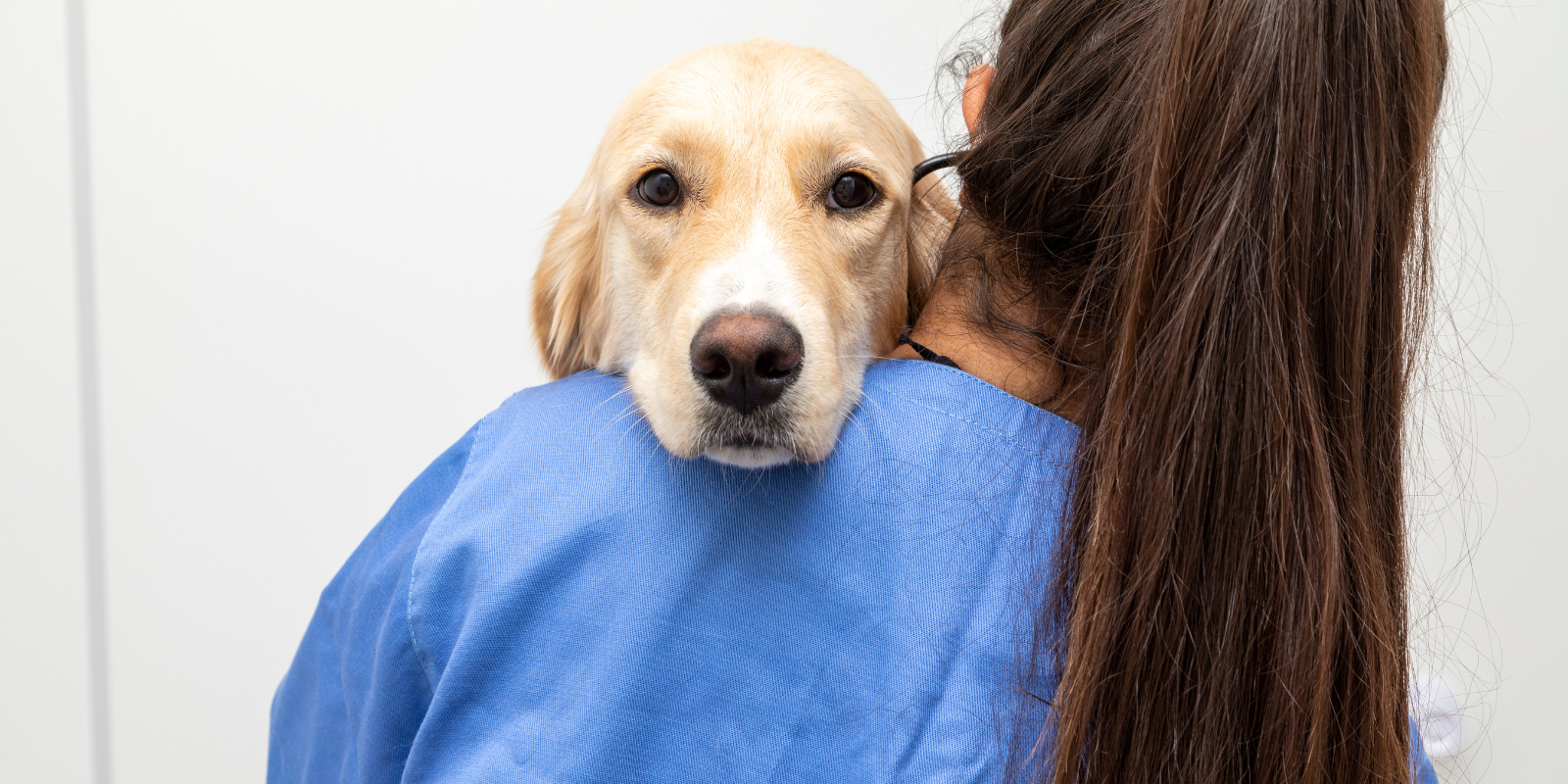When Paul Bunn Jr., MD, arrived in Colorado in 1984 to head the new Division of Medical Oncology at the University of Colorado, he had no idea that he would be asked to lead the monumental effort to create a major cancer center at the university, and that he would then spend more than two decades as its director.
“They had an opening at the division, and I was recruited,” Bunn recalled recently. “There was no cancer center at the time, and no discussion about me being the cancer center head.”
And yet, soon after Bunn arrived at what was then called the CU Health Sciences Center, on a densely packed campus at Ninth Avenue and Colorado Boulevard in central Denver, Bunn was tapped to head a committee to create the University of Colorado Cancer Center, which was officially established in 1985.
“When the cancer center first got funded, there was nothing else like it between the Mississippi River and California,” Bunn says. “We were it.”
“He started from scratch with the cancer center,” John Minna, MD, of the University of Texas Southwestern Medical Center, a longtime friend and colleague of Bunn’s, said in a 2018 interview. “It was a lot of recruiting and hard work. I give him a huge amount of credit.”
Redefining and revolutionizing
Today, the program Bunn and his colleagues launched is Colorado’s only comprehensive cancer center designated by the National Cancer Institute (NCI), and one of only five such centers in the Mountain Time Zone.
For 40 years, the CU Cancer Center has been the home of important scientific and clinical breakthroughs, of clinical trials bringing new treatments swiftly to patients, and of crucial training for the next generation of cancer healers. It draws together cancer researchers and clinicians across various schools on the CU Anschutz Medical Campus and CU’s other campuses, as well as Colorado State University.
CU Cancer Center members provide care at UCHealth University of Colorado Hospital (UCH) and its Anschutz Cancer Pavilion, along with other UCHealth sites; at Children’s Hospital Colorado; and at the U.S. Department of Veterans Affairs’ Rocky Mountain Regional Medical Center—all adjacent to one another. Members also practice at Denver Health and National Jewish Health.
In its four decades, the CU Cancer Center has seen a move to a new campus and construction and expansion of the cancer pavilion. It has scored recruitment wins of superstar researchers and undergone enormous growth of its membership, programs, and facilities. And it helped pioneer the concept of multidisciplinary clinics for treatment of specific cancers, with patients evaluated by dozens of specialists in one day.
“The CU Cancer Center has been the hub of cancer research and care in this state and this region for nearly four decades,” CU Anschutz Chancellor Donald Elliman Jr. told visiting Colorado state legislators in 2024. “Our goal is to provide not only world-class care as it exists today, but also to take a major role in redefining, and in some cases revolutionizing, what that care could look like into the future.”
Says Richard Schulick, MD, MBA, who has been the CU Cancer Center’s director since 2018: “When you look at all that’s been accomplished, you’d have to say our stature is rising. We’re cooking.”
Photos at top: Left, Paul Bunn Jr., MD, the CU Cancer Center's founding director, in a 1988 Denver Post photo via Getty Images. Right, Richard Schulick, MD, MBA, CU Cancer Center director since 2018, in surgery.

A 1982 aerial view of the University of Colorado Health Sciences Center at Ninth Avenue and Colorado Boulevard in Denver. Photo from the CU Strauss Health Sciences Library.
War on Cancer
In 1971, President Richard Nixon declared a national “War on Cancer,” and in December of that year he signed the National Cancer Act, enlarging the role of the NCI in developing a national program to study and fight cancer. Under the act, the NCI was directed to designate 15 new cancer research centers across the country.
Cancer centers and dedicated cancer hospitals had existed as far back as the late 1800s. The New York Cancer Hospital (later Memorial Sloan Kettering Cancer Center) opened its doors in 1887 and later began research programs. But the 1971 legislation created a national framework for NCI-designated cancer centers that met the agency’s standards for state-of-the-art research focused on finding new and better ways to prevent, diagnose, and treat cancer.
The 1971 law also expanded the NCI’s program of providing major sustained funding in the form of P30 Cancer Center Support Grants—called “core grants”—to promote the stability and development of cancer centers.
Soon there were NCI-designated cancer centers in the Pacific, Central, and Eastern time zones, but the Rocky Mountains were a blank space, which meant residents had to travel great distances to obtain treatment at a major cancer center.
In the 1970s, a Colorado consortium of nonprofits, hospitals, and private-practice cancer-care providers succeeded in obtaining an NCI core grant, but the grant was not renewed after one year, Bunn says. That effort was not led by CU.
In 1978, Richard Lamm—in his first of three terms as Colorado governor—formed a “Cancer Control and Research Panel” of officials, medical leaders, and the public to examine the issue and report back. Over the next few years, Lamm’s panel, along with CU leaders, concluded that a university-coordinated cancer center dedicated to research, treatment, and education would stand a better chance of securing sustained NCI support.
Reapplying for an NCI grant
To make it happen, the CU Health Sciences Center turned to Bunn, a lung cancer specialist whom Minna described as a “person of huge integrity” and “tremendously well organized.” Bunn had spent 11 years working for the NCI in various capacities.
Bunn was recruited to CU in 1984 by Robert Schrier, MD, who in 1976 was appointed chair of the CU Department of Medicine, and later founded the Division of Medical Oncology within the department.
A short time later, Bunn was approached by Joseph St. Geme Jr., MD, the newly appointed dean of the CU School of Medicine. “The dean asked me if I could put together an effort to reapply for an NCI cancer center grant,” Bunn says.
St. Geme put Bunn in charge of a planning committee that included representatives of CU and various Colorado cancer research groups. The committee recommended formation of a collaborative cancer center based at the CU Health Sciences Center and affiliated with Denver-area hospitals. Cancer-focused faculty from various Colorado campuses would become members. The former AMC Cancer Research Center and Eleanor Roosevelt Institute for Cancer Research, both in Denver, played key roles in the CU Cancer Center’s formation, Bunn says.
St. Geme approved the plan, and the School of Medicine issued a charter for the CU Cancer Center in 1985. Bunn was named its first director.
Bunn also led the effort to have the nascent CU Cancer Center designated by the NCI as a clinical cancer center, an introductory level. The CU Cancer Center achieved that designation, and the center’s first NCI core grant award took effect March 1, 1988. Also in 1988, UCH—at that time also located on the Ninth and Colorado campus—created a dedicated inpatient cancer care center.

Key figures in the CU Cancer Center's early history. From left: former CU Department of Medicine Chair Robert Schrier, MD, who recruited Paul Bunn, Jr., MD, to CU; Joseph St. Geme Jr., MD, a former dean of the CU School of Medicine, who put Bunn in charge of organizing the CU Cancer Center; Richard Krugman, MD, a longtime CU School of Medicine dean and a staunch supporter of the CU Cancer Center; Dan Theodorescu, MD, PhD, who succeeded Bunn as CU Cancer Center director.
A different world
When the CU Cancer Center was born, cancer treatment and care—and the outlook for patients—looked much different than they do today.
In 1985, the death rate from all cancers in the United States was about 170.5 per 100,000 people, well above the rate of 140 deaths per 100,000 in 2022. U.S. death rates for cancers of the lungs, colon, and prostate among men were at or near their historic peak that year, as were death rates for breast cancer among women.
In 1985, lung cancer was mostly treated by aggressive surgery. Radiation and chemotherapy were primarily seen as palliative treatments. Most lung cancer cases weren’t diagnosed until the disease had metastasized, and only about a third of patients with advanced disease lived more than a year after diagnosis.
It was the year that breast-conserving surgery (“lumpectomy”) coupled with radiotherapy was found to be an effective alternative to radical mastectomy in treating breast cancer, and the HER2 gene as a factor in breast cancer had just been discovered.
And 1985 was the year before the first immunotherapy agent for cancer—interferon-alpha 2—was approved by the U.S. Food and Drug Administration for use in hairy cell leukemia. The revolution in targeted cancer therapies would come years later, and breakthroughs such as CAR T-cell therapy, checkpoint inhibitors, and personalized cancer vaccines were still decades away.
In the decades to come, the CU Cancer Center would play a key part in answering questions about cancer, developing new preventive techniques and therapies, and improving the outlook for cancer survivors.

Early philanthropic milestones for the CU Cancer Center. Left, in an undated photo, CU Cancer Center Director Paul Bunn Jr., MD, receives a donation from philanthropist Michael Geller following a Wines for Life fundraiser, which Geller founded in honor of his late brother. Right: Olympic gold-medal skaters Scott Hamilton and Peggy Fleming, both cancer survivors, with actor Billy Crystal at a 1998 CU Cancer Center fundraiser.
Growing by leaps and bounds
When Bunn arrived at CU, “there were, maybe, two medical oncologists and three hematologists on faculty,” he says. “Radiation oncology wasn’t even a department yet.”
In those days, he says, “people were generalists. Pretty much everybody saw everything. It became obvious that that wouldn’t work, because things became too complicated. So people became much more specialized. For example, we needed to have a lung clinic and a lung group. Same with breast cancer, GI cancer, and colon cancer. We started various specialty groups that just grew and grew.”
Growth came quickly in the CU Cancer Center’s early years at the Ninth and Colorado campus, Bunn says. In 1986 it had 174 members, reported $22.8 million in grants and contracts to its members, and had 315 patients enrolled in its clinical trials. By 2000, those numbers had grown to 280 members, $72.7 million in grants, and 4,133 patients in trials. “Medical oncology, radiation oncology, and pediatric oncology were all growing by leaps and bounds,” Bunn says.
The CU Cancer Center acquired its first dedicated research space in 1992. In 1993, UCH opened an outpatient cancer facility in an adjacent unused medical building, and the hospital expanded radiation and chemotherapy facilities in 1998. The cancer center in 1996 began advanced radiation treatment to selectively target prostate cancer. And in the 1990s, both UCH and Children’s Colorado launched bone marrow transplant programs and opened what was then the region’s only cord blood bank.
Upgrade to comprehensive
During the CU Cancer Center’s roughly two decades in central Denver, its investigators made important discoveries, gaining a better understanding of the fundamental biology of cancer. Members discovered the nature of the T-cell receptor, its function, and structure; developed a new nomenclature of chromosome identification; described tumor suppressor genes involved in lung and kidney cancer; and defined the role of androgen inhibitors in the treatment of prostate cancer.
Members also pioneered various cancer therapies that became widely adopted. And they helped define the role of nutrition and diet in cancer development and prevention.
Bunn says that with growing specialization, “it was clear that multidisciplinary clinics were needed—having the surgeons, the radiation oncologists, and the medical oncologists in the same area at the same time with the social workers and the support staff. We went from having no multidisciplinary clinics to clinics for every kind of cancer. It was a completely different concept.”
In 1997, the NCI upgraded the CU Cancer Center to the “comprehensive” level, a status it has retained ever since through a series of rigorous five-year renewal reviews. The comprehensive designation recognizes depth and breadth of transdisciplinary research and community outreach programs, in addition to excellence in clinical care.
The following year, actor Billy Crystal—fresh from emceeing the 1998 Academy Awards broadcast—helped the cancer center celebrate the 10th anniversary of its first NCI core grant by emceeing a black-tie benefit that raised more than $500,000. The event honored Peggy Fleming and Scott Hamilton, Olympic gold-medal skaters and cancer survivors.

Left: Construction of what would become the Anschutz Outpatient Pavilion and the Anschutz Cancer Pavilion in an early 2000 photo. Right: The Anschutz Cancer Pavilion today, following a major expansion in 2012.
Move to Aurora
By the closing years of the 20th century, continued growth of the CU Health Sciences Center, the CU Cancer Center, and UCH meant the central Denver campus was bursting at the seams. Expansion plans were announced in 1992, but new neighborhoods had grown up around the campus, and residents opposed a bigger footprint.
Another problem was that Children’s Colorado—also squeezed for space—was located several miles away, meaning lost time for CU Cancer Center members commuting back and forth between the hospital and the university campus.
Meanwhile, about seven miles east, in the neighboring city of Aurora, the U.S. military had placed its aging Fitzsimons Army Medical Center on the base closure list in 1995. CU leaders saw an opportunity to move to a spacious new site, and they asked the federal government and the city of Aurora for 186 acres (later expanded). The government agreed, and in 1998, CU and UCH completed a joint master plan for relocating to Aurora.
The Children’s Colorado board in 2003 approved plans to move to the Fitzsimons campus as well and broke ground the following year. The hospital is the site of the CU Cancer Center’s top-ranked pediatric oncology program. And soon the VA decided it would build a huge new medical center next door to the new campus, replacing its central Denver hospital. For the first time, all three of the CU Cancer Center’s main clinical partners would be adjacent to one another, to the cancer center, and to CU.
CU retained Fitzsimons’ signature Building 500, which had opened in 1941 as an Army hospital. For many years to come, the rest of the site would see construction of a forest of new buildings for education, research, and patient care.
The CU Cancer Center was one of the first CU units to plant its flag at the Fitzsimons campus. Ground broke on the 93,000-square-foot Anschutz Cancer Pavilion in May 1999, funded in part by a $25 million gift from Colorado businessman Philip Anschutz’s Anschutz Foundation. The pavilion opened in November 2000. The entire campus was named the CU Anschutz Medical Campus in 2006 in recognition of additional major gifts from Anschutz and his foundation.
The CU Cancer Center gained an important research partner in 2002 with the opening of the Flint Animal Cancer Center (FACC) at CSU. FACC Director Susan Lana, DVM, and a number of the center’s researchers are CU Cancer Center members, collaborating on one of the most advanced comparative oncology research programs in the world, seeking to translate research on prevention, diagnosis, and treatment of naturally occurring cancer in pet animals to benefit people.
Key areas of CU Cancer Center collaboration with the FACC are testing CAR T-cell therapies, establishing how to combine radiation with immunotherapies in treating head and neck cancers, and exploring how to save limbs through salvage surgeries in patients with osteosarcoma.
Director transitions
After overseeing the CU Cancer Center’s move, Bunn stepped aside as director in 2009.
“Writing a core grant is a lot of work,” Bunn says with a grin. “I guess I did it five times, which was more than enough. It was time for some fresh blood.”
A party marking the end of Bunn’s leadership tenure at the cancer center was covered by The Denver Post and drew 300 people from around the world. At the time, then-NCI Director John Niederhuber called Bunn “one of our nation’s heroes in the struggle to overcome cancer.”
Dan Theodorescu, MD, PhD, became CU Cancer Center director in 2010, succeeding interim director Tim Byers, MD, MPH. A urologic oncologist, Theodorescu led the center through two grant renewal cycles, the most recent in 2017. During his tenure, in 2012, the Anschutz Cancer Pavilion opened a 40,000-square-foot, $20 million expansion, adding space for several cancer treatment programs, and increasing treatment capacity by 60%.
“Our investigators lead the way in identifying cancer targets and biomarkers and in developing personalized medicine for our patients.” Theodorescu said in a 2012 article.

CU Cancer Center Director Richard Schulick, MD, MBA (left) at a multidisciplinary clinic.
‘I hate cancer’
In 2018, Schulick was appointed the new director of the CU Cancer Center, succeeding Theodorescu. A renowned surgical oncologist, Schulick had already been chair of the CU Department of Surgery since 2012, leading its steady expansion. Schulick had pioneered a pancreatic multidisciplinary clinic soon after his arrival on the CU Anschutz campus.
Asked recently why he was willing to take on such a large additional administrative burden, Schulick says: “Cancer has always been a big part of the Department of Surgery and of what I do. I thought this would be a great way to further get into the fray against cancer. And as leader of both the surgery department and the cancer center, I don’t have to argue with myself, and there are things I can get moving faster because I lead both.”
In a 2024 speech to visiting Colorado lawmakers, Schulick spoke in personal terms about why he enlisted in the war on cancer: “Both of my parents had cancer, and I hate cancer.” He asked everyone in the audience to raise their hands if they had a friend or relative with cancer, or if they themselves had been diagnosed with cancer. Everyone raised their hands.
When Schulick became director, the defining concept of cancer had recently undergone a major change. “We used to define cancer by where it lives in the body—‘lung cancer,’ ‘breast cancer,’ ‘prostate cancer,’ etc. And the way we studied and treated the disease was compartmentalized, too,” he wrote recently.
“The decade of the 2010s turned this model on its head," he added. "Now we know that cancers may be better defined by their genetic changes than by where they live in the body; we know that what surrounds a tumor can be as important as the tumor itself; we know that cancer is only one part of a patient’s life; and we know that it takes interconnected teams of scientists, doctors, patients, and philanthropists to make inroads against this family of diseases.”

The CU Cancer Center leadership team in 2021.
New leaders and programs
Schulick has two deputy directors: Cathy Bradley, PhD, who oversees cancer prevention and awareness programs; and James DeGregori, PhD, focused on basic science and translational activities.
Shortly after Schulick became director, the CU Cancer Center, bolstering its outreach mission, recruited Evelinn Borrayo, PhD, as associate director for community outreach and engagement, focusing on better serving people in underserved communities and rural areas in Colorado. And Eduardo Davila, PhD, was promoted in 2019 to associate director of the center’s Cancer Research Training and Education Coordination (CRTEC) program, which aims to foster the careers of cancer care providers, new investigators, and aspiring young scientists.
The CU Cancer Center again bolstered its leadership ranks with the 2023 arrival of associate director Miria Kano, PhD, and deputy associate director Curtis Henry, PhD, to lead its Office of Engagement, Access, and Success. And in 2024, Enrique Soto Pérez de Celis, MD, PhD, was recruited to be associate director for global oncology, fostering research partnerships with cancer centers in other nations.
In 2022, the Katy O. and Paul M. Rady Esophageal and Gastric Center of Excellence was established at the CU Cancer Center through a $20 million gift from the couple. Katy Rady’s brother, Paul O’Hara, had come to the CU Cancer Center for treatment of advanced esophageal cancer. O’Hara died in 2015, but the quality of care he received convinced the Radys to fund the new center of excellence to accelerate the pace of research for esophageal and gastric cancer. Gastroenterologist Sachin Wani, MD, one of Paul O’Hara’s doctors, was appointed its director.
Also in 2022, CU Cancer Center member Terry Fry, MD, a noted expert and pioneer in CAR T-cell therapy, was chosen to lead at new venture at CU Anschutz, the Gates Institute, with the aim of spurring advances in cell and gene therapies, including CAR T-cell therapy trials for various cancer types.
The Gates Institute is fueled by a $200 million philanthropic investment from the Gates Frontiers Fund with the goal of swiftly move scientific discoveries from the lab to the clinic.

CU Cancer Center research in action. From left: the labs of James DeGregori, PhD; Heide Ford, PhD; and Eduardo Davila, PhD.
Accelerating progress
Since Schulick became director, he and his team have built upon “what already was an excellent cancer center before,” he says. “We’ve increased our funding in terms of NCI grants, other NIH grants, and grants from other places. A lot of great discoveries have been made here in the last seven years that have translated to clinical trials and gone to the FDA for approval. We’re accelerating our progress against cancers in general, and we do this by recruiting and retaining top talent and giving them the resources they need to get things done.”
In recent years, CU Cancer Center members have identified potential new drug targets for breast cancer, leveraged genomics data to identify better therapies for patients with solid tumors, targeted stem cells in treatment for acute myeloid leukemia, and developed an intervention to reduce stress in caregivers for people with cancer.
In 2024 it launched a multiyear project to improve models for evaluating potential cancer-fighting therapies before they go to clinical trials, led by Hatim Sabaawy, MD, PhD, who was recruited in 2022 as the CU Cancer Center’s associate director of translational research.
The CU Cancer Center also has delved into ways to use artificial intelligence to enhance research, practice, and education through advanced analytics of data, and in 2020 brought in Sean Davis, MD, PhD, as associate director of informatics and data science.
In addition to its sustained NCI comprehensive cancer center designation, most recently renewed in 2022, Schulick points to the CU Cancer Center’s status as a member of the National Comprehensive Cancer Network (NCCN), which it first achieved in 2013. NCCN is a nonprofit alliance of 33 leading cancer centers dedicated to advancing patient care, research, and education. Organizations like NCCN “help write the global recommendations for how to treat cancer,” Schulick says.
In fiscal year 2024, the CU Cancer Center reported 278 full and mentored members, $75 million in grants, and 6,108 patients in clinical trials.

CU Cancer Center leaders meet. From left: Stacy Fischer, MD; Evelinn Borrayo, PhD; Linda Cook, PhD; Jamie Studts, PhD; and Cathy Bradley, PhD.
‘We should all be quite proud’
Across 40 years, the CU Cancer Center’s goals have remained constant, Schulick says.
“It’s all about the cancer patient and their family. We have four main goals. One is to prevent cancer altogether. And number 2, if people develop cancer, let’s have better screening methods to catch it early so we can cure it. Number 3, if you can’t catch it early, then let’s have great treatments. Traditionally we’ve used chemotherapy, surgery, and radiation. But in the last decade or so, immunotherapy has become quite successful, and targeted therapies have done great things. We need to keep developing those.
“And number 4, it’s a shame, but the patient does not always get connected to the right therapy. Sometimes it’s their lack of access to great cancer centers. Sometimes it’s education. Sometimes it’s their insurance status. But as a country, as a community, we need a better way to make sure that all Americans get the care they need.”
After a pause, Schulick says: “I’d be the happiest man on earth if I woke up one day and said to myself, ‘There’s no more cancer. You have to find something else to do.’”
Bunn, named a distinguished CU professor in 2013, remains a part-time faculty member, sees about 10 patients a week, and serves on a committee monitoring clinical trial safety. He cites longtime former CU School of Medicine Dean Richard Krugman, MD, as well as Rae Ann Paden, Mark Kochevar, Libby Printz, and Michaela Montour, among many key leaders who helped to support and build the CU Cancer Center over its 40-year history.
“I’m quite proud of what happened,” he says of the CU Cancer Center. “Lots of people participated, and we should all be quite proud.”
CU Cancer Center Timeline
1985: The CU Cancer Center is chartered under the CU School of Medicine.
1988: The National Cancer Institute (NCI) designates the CU Cancer Center as a clinical cancer center, the first in the Rocky Mountain region.
1997: The NCI elevates the CU Cancer Center to “comprehensive cancer center” status, which it has retained ever since.
1998: CU and University of Colorado Hospital complete a joint master plan for a move from central Denver to Aurora.
1999: Groundbreaking on what would become the Anschutz Cancer Pavilion.
2012: The Anschutz Cancer Pavilion opens a major expansion, enlarging treatment capacity by 60%.
2022: The most recent renewal of the CU Cancer Center’s NCI comprehensive cancer center designation.
